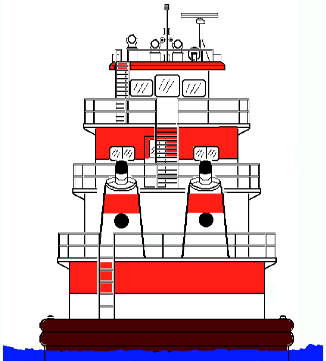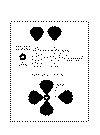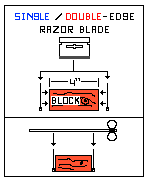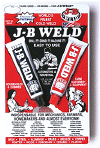|


















Which Prop = Goes Where - On
Boats?
A Lot of
modelers get confused about this issue. So I created these Moving
Drawings - Below, to help ease some of the confusion. And by the way
- Guys .... "Propellers" are called = "Wheels" in Workboats, a term
from steamboat days that's still respectfully used by Tradition.
And Remember .... A boat always
has the tendency - to turn, in the very same direction, as its -
Propeller Is Turning. And these drawings below, show this and how
this effect can be canceled by using opposite turning wheels = props.
Just remember that these drawings show the vessel always - Going Ahead,
while your looking at the -
STERN!

RH Prop

 torque
torque
Single Screw Boats,
typically use a "RH - Propeller", so this
means the propeller - torque will always try to turn the vessel -
Starboard or "Right". Naturally if a the boat uses a "Left Hand"
Prop, this would cause the torque to turn the vessel = to Port!

LH-Prop torque



 RH-Prop torque
RH-Prop torque
Twin Screw Boats....
use both = LH & RH Props, also called
wheels, fro steamboat days. Note how twin screw - propellers are
OFF SET from the exact center line of the hull. So each
propellers - torque as it spins, has its hull torque, canceled out.
If you used a RH turning prop = on the Port side, its torque would have
a drastic effect and would make the vessel steer much harder.
Therefore the use of Left / Right Hand turning props, helps to cancel
these effects on vessels. Reducing Hull - Torque, can also be
enhanced by the use of special - Spit Rudders, called Contrguide
Rudders. ( See Below Info )
_____________________________________________________________________________

( 1 ) LH Prop
  (
2 ) RH Props (
2 ) RH Props
torque


 torque
torque
Triple Screw Boats,
use a combination of 2 = RH
props, with a LH turning propeller. And the In-board engine - is used
primarily, for additional power and not generally used when doing
close-in maneuvers. When
maneuvering, pilot's more often used the two "Outboard Engines", because
they apply a greater angle on the thrust provided by the boat.. But
when needed, pilot's use all 3 - engines, to manhandle tows that require
gentle, skillful - pressure and this means the outboard engines are the
most often used on these huge towboats.
_____________________________________________________________________________
Making Scratch - Wheels =
Props!
Hey Guys ....
Remember those fancy little "Rubber Fishing Worms", that ya got hidden
away in your ole Tackle Box? ......"Yeah - those little fancy tiny
"Chrome Propellers" or Spinner's, that are mounted on them lil tiny
rubber worm lures. Yeah, the ones you've meant to always throw away
and replace, because their - all worn out! ...... Well if you wanna make
"Tiny Propellers" for a scale model boat, take a pair of those little -
2-blade spinners and cross them, and you've got a four blade = PROP!
.... NEAT HUH. Made in just seconds, using a solder gun to weld the
spinners together and mount them on a length of brass tubing used as the
drive shaftl - Now Ain't
That A - Kick In The Head!
Tap
Drawing To Enlarge
 Purchase "Flat Brass" Sheets in about ( 3/16 to 3/32
thickness - depending on your needs. And also purchase some - Heavy
Brass - Brass Bushings, at your local hardware store. Then trace your
"Fluke" patterns, onto the brass sheets and cut them - Out. Use a
metal blade in a band saw - for example, or a Dremel tool & metal
cut-off wheel. Sand / Polish & then solder all parts - together, with
a Solder Iron or Gun, or Small Torch set at low temps to avoid ruining
the metal. My own preference, is a 75/ 150 Watt
- Solder Gun!
NOTE ......
The Bushing - must have "Angled Notches",
cut into it, so it holds each of the 4 - flukes that make-up the wheel =
Prop. ((( Bushings are found at
Bearing Suppliers, or Auto Parts )))
And I use a Dremel tool or Hack-saw, to make the notches - for each
Fluke, on bushings. so their positioned carefully to insure the wheel,
will spin perfectly smooth & true. When cutting - the notch into the
bushing, Take note of the direction you cut the notch, to determine
which direction the prop - Will Turn. That just means you change the
direction of the notches on the Bushings, so you can make Left or Right
- Hand Turning - Props. And this
Idea - also easily makes 2
- 3- 4 - 5 or even 6 - bladed propellers = in versions. And sure
saves a lot of bucks, especially -
if you can't find a purchased prop in the right diameter, Or Style
Needed?
Purchase "Flat Brass" Sheets in about ( 3/16 to 3/32
thickness - depending on your needs. And also purchase some - Heavy
Brass - Brass Bushings, at your local hardware store. Then trace your
"Fluke" patterns, onto the brass sheets and cut them - Out. Use a
metal blade in a band saw - for example, or a Dremel tool & metal
cut-off wheel. Sand / Polish & then solder all parts - together, with
a Solder Iron or Gun, or Small Torch set at low temps to avoid ruining
the metal. My own preference, is a 75/ 150 Watt
- Solder Gun!
NOTE ......
The Bushing - must have "Angled Notches",
cut into it, so it holds each of the 4 - flukes that make-up the wheel =
Prop. ((( Bushings are found at
Bearing Suppliers, or Auto Parts )))
And I use a Dremel tool or Hack-saw, to make the notches - for each
Fluke, on bushings. so their positioned carefully to insure the wheel,
will spin perfectly smooth & true. When cutting - the notch into the
bushing, Take note of the direction you cut the notch, to determine
which direction the prop - Will Turn. That just means you change the
direction of the notches on the Bushings, so you can make Left or Right
- Hand Turning - Props. And this
Idea - also easily makes 2
- 3- 4 - 5 or even 6 - bladed propellers = in versions. And sure
saves a lot of bucks, especially -
if you can't find a purchased prop in the right diameter, Or Style
Needed?
Tap
Drawing To Enlarge
 Prop Making ..... Diagram # 2.
This drawing can be used for making props, used on
Drive shafts that have Threaded Ends. Here, Two Nuts are used to
hold or clamp the brass propeller patterns - together, making up a 2 or
4 or even a 6 bladed version. Note, the first two drawings (
L to R ), are for use in "Kort Nozzles" on
modern Tugs & Towboats aqnd you can adjust the drawings size - the
drawings diameters ( increase or decrease the pattern size ), to
suit your needs in any scale to fit a project!
Prop Making ..... Diagram # 2.
This drawing can be used for making props, used on
Drive shafts that have Threaded Ends. Here, Two Nuts are used to
hold or clamp the brass propeller patterns - together, making up a 2 or
4 or even a 6 bladed version. Note, the first two drawings (
L to R ), are for use in "Kort Nozzles" on
modern Tugs & Towboats aqnd you can adjust the drawings size - the
drawings diameters ( increase or decrease the pattern size ), to
suit your needs in any scale to fit a project!
_____________________________________________________________________________
Balancing
a Prop & Shaft
Regardless of the type, or size of a Drive Shaft - "It needs balancing"
to reduce hull vibration. Because that robs - shaft rpm and motor
speed and power and reduces a models performance. All this, is just
as critical - in a workboat, as it would be, in a Race Boat!
 Use a 4 to 6" length of scrap - block of wood,
and glue a pair of "Single or Double - Edged Razor Blades" to each end
of the block, as shown in this drawing. Making sure they are level
with one another. Then lay your Drive Shaft & Prop, across the
blades, which is now the balancer, to check them ( as shown in the
bottom drawing ). The heavy side - of the drive shaft, will roll to
the bottom and Indicates a need for a small amount of weight needs to be
removed. "Polish Off" a small portion of the "Solder" around the Prop
or in the heavy areas of metal on the Prop. Also check the props -
fluke, are they the same pitch and same lengths, by slowly turning the
prop = wheel, with an object close to them, for measuring a crooked
prop. These steps will gain a better balance to the shaft and make
balancing easier. Then rotate and recheck - balance again, to insure -
its right, or repeat until correct. NOTE ... Be
sure the table your using, is also "LEVEL", before you use this system
on it. Because it can effect - Shaft balance sometimes - if your not
careful.
This balancer, is not made to adjust
"High Speed" props for Race Boats, but it works on much the same
principle. And its cheaper than buying one - For Sure!
Use a 4 to 6" length of scrap - block of wood,
and glue a pair of "Single or Double - Edged Razor Blades" to each end
of the block, as shown in this drawing. Making sure they are level
with one another. Then lay your Drive Shaft & Prop, across the
blades, which is now the balancer, to check them ( as shown in the
bottom drawing ). The heavy side - of the drive shaft, will roll to
the bottom and Indicates a need for a small amount of weight needs to be
removed. "Polish Off" a small portion of the "Solder" around the Prop
or in the heavy areas of metal on the Prop. Also check the props -
fluke, are they the same pitch and same lengths, by slowly turning the
prop = wheel, with an object close to them, for measuring a crooked
prop. These steps will gain a better balance to the shaft and make
balancing easier. Then rotate and recheck - balance again, to insure -
its right, or repeat until correct. NOTE ... Be
sure the table your using, is also "LEVEL", before you use this system
on it. Because it can effect - Shaft balance sometimes - if your not
careful.
This balancer, is not made to adjust
"High Speed" props for Race Boats, but it works on much the same
principle. And its cheaper than buying one - For Sure!
_____________________________________________________________________________
Tools Required To Make A - Prop
Balancer
#1 ...
Dremel Tool & Bitts = Cut-off Wheel, Sanding Drum... to cut and shape
parts.
#2 ...
Solder Iron or Solder Gun, plus tip cleaning tools, or a Small Propane
Hobby - Torch.
#3 ...
60/40 Rosin Core - Electronic Solder and Soldering Paste.
#4 ...
200 Grit - Sandpaper, to clean and polish brass tubing ( All Points ),
prior to soldering and assembly.
#5 ...
Bench Vice - to hold parts for assembly.
#6 ...
Scrap block of wood, approx - 4 to 6 inches long.
#7 ...
50/50 epoxy Glue, or CA Glue to weld Razor blades to Wooden block!
_____________________________________________________________________________
Polishing - Brass
Naturally
you want new - Props, to look their best, regardless of whether you made
them or purchased them from a hobby supplier. So here is how you can
polish them - to a real professional shine.
#1 - Small bottle of
"SNOW BOWL" Toilet Cleaner. .... "CAUTION = Use
Gloves & Ventilation with Acids!"
#2 - Rubber Gloves /
Goggles & A small Jar = 1/2 full of Snow Bowl
#3 - An Empty - 1
Gallon Paint - CAN, with Lid ...... ( Fill - half
full of = SAND )
#4 - 1 Package of
"Fine Grade" - Steel Wool
#5 - A "Reversible -
Variable Speed = Electric Drill"
#6 - Johnson's - Floor
Wax ( Paste ).... Adds Shine - to Brass Props - When On Display!
STEP ONE
- REMOVING SCRATCHES & POLISHING = Using an
Electric Drill, to spin your wheels = props ( Mounted on their -
Drive Shafts ), with the shaft connected to an electric - hand drill.
Placing the prop slowly - as its turned, down into the Paint Can, filled
with Sand and about 2/3's - full of Hot Water. Spin the props - in
both directions for short periods, checking your progress. NOTE - The
sand can be finely sifted - If desired, using some "Old Window Screen"
to remove larger granules. And to remove basic tarnish & scratches,
this method works fine with ordinary sand and warm water, then dip the
props into a small jar, with some Snow Bowl Toilet Cleaner. Leave
them only a few seconds, then rinse with fresh water, or they will turn
black, from the acid. USE
CAUTION - With Snow Bowl, its a Toxic Acid to skin, Eys and your Nose!
.....So Use Rubber Gloves and Eye Protection in a well = Vented Area!!
Steel Wool
- can then be used on rough areas, where "Water /
Sand or Snow Bowl", didn't completely clean or polish the brass.
Then use automotive - paste wax, or Johnson's Floor = Paste Wax, to
polish and shine props to much brighter luster
_____________________________________________________________________________
Kort Nozzles
Korts as their called,
are different looking on Towboats, from those used on
other types of Workboats. And below are a couple of examples, because
there are several styles and they fit different applications.
Sometimes equipped with Pintle Bearings for the stern- rudder, which
means they have included = rudder posts, or skid plates that hold the
lower part of stern rudder as well. And then there are Korts - That
don't have such additions, and their shapes can vary greatly from what
you might be used to seeing or expect - if your a Tug Modeler and
Towboat are new to you.
Tap
Photo to Enlarge
 The Hull of the model - Thomas K. with its tin can
"Homemade" - Kort Knozzels, lined with small wood strips - glued into
place, then sanded to the kort - interiors proper shape. The kort is
embedded into the hull, and filler has been used to smooth the hull &
korts - mounting areas.
The Hull of the model - Thomas K. with its tin can
"Homemade" - Kort Knozzels, lined with small wood strips - glued into
place, then sanded to the kort - interiors proper shape. The kort is
embedded into the hull, and filler has been used to smooth the hull &
korts - mounting areas.
Tap Photo to Enlarge
  "Standard Korts on a towboat"
Mounted on what's called a Tunnel = or Tunnel Stern hull,
which looks like a giant "Spooned Out" area in the upper hull plates,
that embeds the kort further into the hull to protect it. Note also,
these korts have no stern - rudders posts, included on their rear lower
points, and the rudders = Are Removed. Here, the photo shows "Rudder
- Alignment Frames", being used to "Remove Or Re-mount" the rudders
during a dry-docking. Note also that the korts ( At Their - Lowest
Points ), are no deeper than the deepest part of the hull - itself.
And if you look closely, you'll see theirs no lower = Pintle Bearing or
Plate to hold the rudders. Here, the stern rudders are separate
items, having no = lower bearings, which usually means their "Break
Away" Rudders, which are not meant to use a lower - Pintle Bearing.
"Standard Korts on a towboat"
Mounted on what's called a Tunnel = or Tunnel Stern hull,
which looks like a giant "Spooned Out" area in the upper hull plates,
that embeds the kort further into the hull to protect it. Note also,
these korts have no stern - rudders posts, included on their rear lower
points, and the rudders = Are Removed. Here, the photo shows "Rudder
- Alignment Frames", being used to "Remove Or Re-mount" the rudders
during a dry-docking. Note also that the korts ( At Their - Lowest
Points ), are no deeper than the deepest part of the hull - itself.
And if you look closely, you'll see theirs no lower = Pintle Bearing or
Plate to hold the rudders. Here, the stern rudders are separate
items, having no = lower bearings, which usually means their "Break
Away" Rudders, which are not meant to use a lower - Pintle Bearing.
_______________________________________________________________________
How To Scratch
Build - Kort Nozzles
For
model Towboats .... use a "Tin Can" or short
length of "PVC" Plastic Sewer or Water Pipe, that's been shaped to the
styles or type Kort Nozzle, your model requires.
Tap
Drawing to Enlarge

 If a Tin Can = IS USED .... It should be lined
outside with small strips of wood, then shaped with sandpaper to proper
shape, then sealed with fiberglass & resin. This insures the wood is
sealed from moisture and damage, while the inner " Tin Can", holds
everything solid, for added strength. The drive shaft will also need
a "Brace" to hold itself = steady inside the kort. This is made by
using two = short strips of brass, installed into 2 - Notches, cut into
the top & bottom of each kort nozzle. These braces are then glued
tightly into place, once their soldered firmly to the drive shaft, so it
can't move inside the kort. Then the shaft is ready to be installed
into the nozzle/ drive shaft housing and the prop or wheel installed.
Here, the kort may, or may not require a "Stern Rudder" = Pintle Bearing
to hold the lower stern rudder. If your model requires such items,
they can easy be formed from brass or plastic and installed on the kort
after their shaped and fitted into a small notch in the rear - lower
part of the kort. NOTE! ..... Korts must always be mounted in place,
using waterproof glue, like a 50/50 Epoxy - I use, to insure they stay
solid and don't break loose .... SEE BELOW!
If a Tin Can = IS USED .... It should be lined
outside with small strips of wood, then shaped with sandpaper to proper
shape, then sealed with fiberglass & resin. This insures the wood is
sealed from moisture and damage, while the inner " Tin Can", holds
everything solid, for added strength. The drive shaft will also need
a "Brace" to hold itself = steady inside the kort. This is made by
using two = short strips of brass, installed into 2 - Notches, cut into
the top & bottom of each kort nozzle. These braces are then glued
tightly into place, once their soldered firmly to the drive shaft, so it
can't move inside the kort. Then the shaft is ready to be installed
into the nozzle/ drive shaft housing and the prop or wheel installed.
Here, the kort may, or may not require a "Stern Rudder" = Pintle Bearing
to hold the lower stern rudder. If your model requires such items,
they can easy be formed from brass or plastic and installed on the kort
after their shaped and fitted into a small notch in the rear - lower
part of the kort. NOTE! ..... Korts must always be mounted in place,
using waterproof glue, like a 50/50 Epoxy - I use, to insure they stay
solid and don't break loose .... SEE BELOW!
Tap
Photo to Enlarge
 REMEMBER = Always use a
glue that can withstand water and moisture, and nothing beats this
stuff! It can be used for gluing hulls together or mounting = Drive
Shafts / Kort Nozzles & Rudders into place on a hull or inside a
Fiberglass hull. J-B Weld is a 50/50 epoxy that auto mechanics use
to seal engine blocks or cylinder heads that have cracks. Once dry,
after about 30 minuets, you can fill any gaps with "Model Plastic -
Filler Putty" or use Automotive filler putty and mold parts into the
hulls overall shape with sandpaper. Available at most Hardware Stores,
Hobby Shops & Auto Parts.
REMEMBER = Always use a
glue that can withstand water and moisture, and nothing beats this
stuff! It can be used for gluing hulls together or mounting = Drive
Shafts / Kort Nozzles & Rudders into place on a hull or inside a
Fiberglass hull. J-B Weld is a 50/50 epoxy that auto mechanics use
to seal engine blocks or cylinder heads that have cracks. Once dry,
after about 30 minuets, you can fill any gaps with "Model Plastic -
Filler Putty" or use Automotive filler putty and mold parts into the
hulls overall shape with sandpaper. Available at most Hardware Stores,
Hobby Shops & Auto Parts.
WARNING! .... Don't ever use common types
of 50/50 = Hobby Epoxy to mount a drive shaft or Rudder system!
..... Those brands of glue - comes loose and
break down after being in contact with moisture. Even if several
coats of paint are applied over the glue, it won't stop moisture from
breaking it down. Modelers often use hobby epoxy on model boats, then
a short time later, suddenly notice it falling apart??? So remember
this, when using typical brands of 50 / 50 hobby epoxy glue, it just
doesn't work! ......And J-B Weld = WILL NEVER FAIL!
I'll Add More - Later,
so check back Often
_______________________________________________________________
Last Updated
On 06/29/23 .
With

|